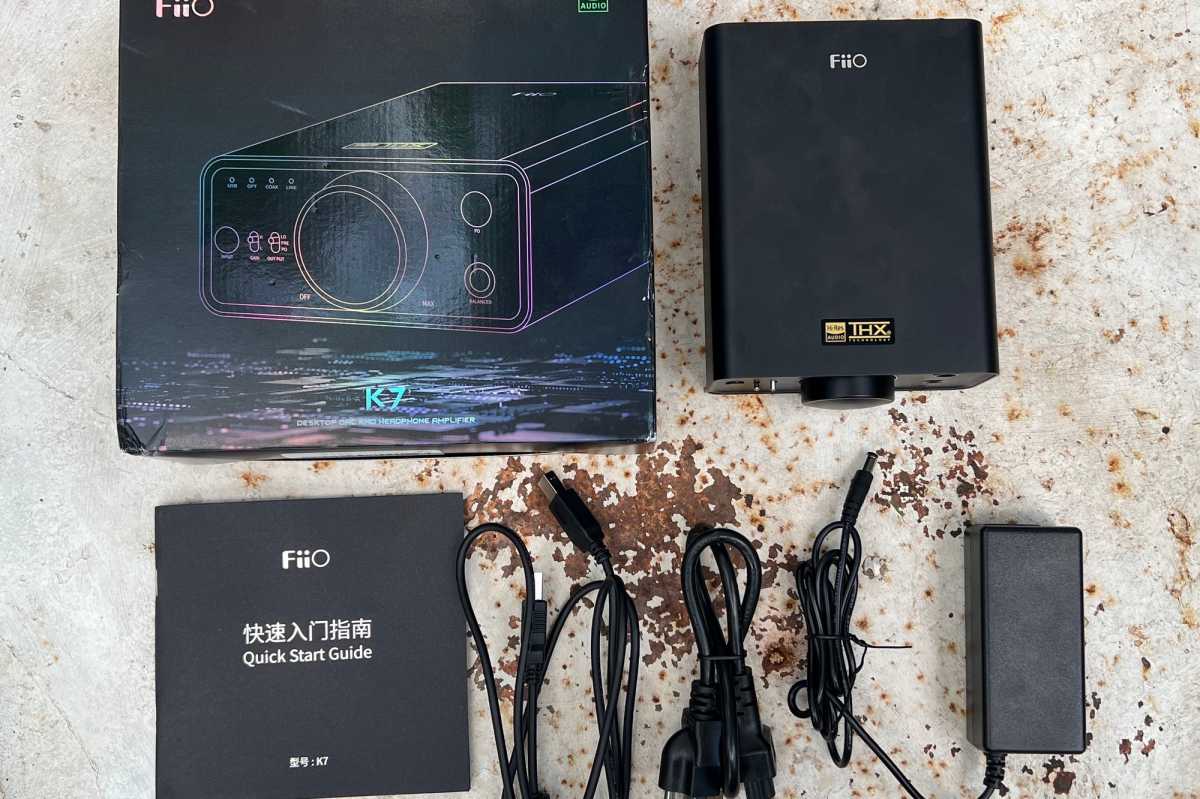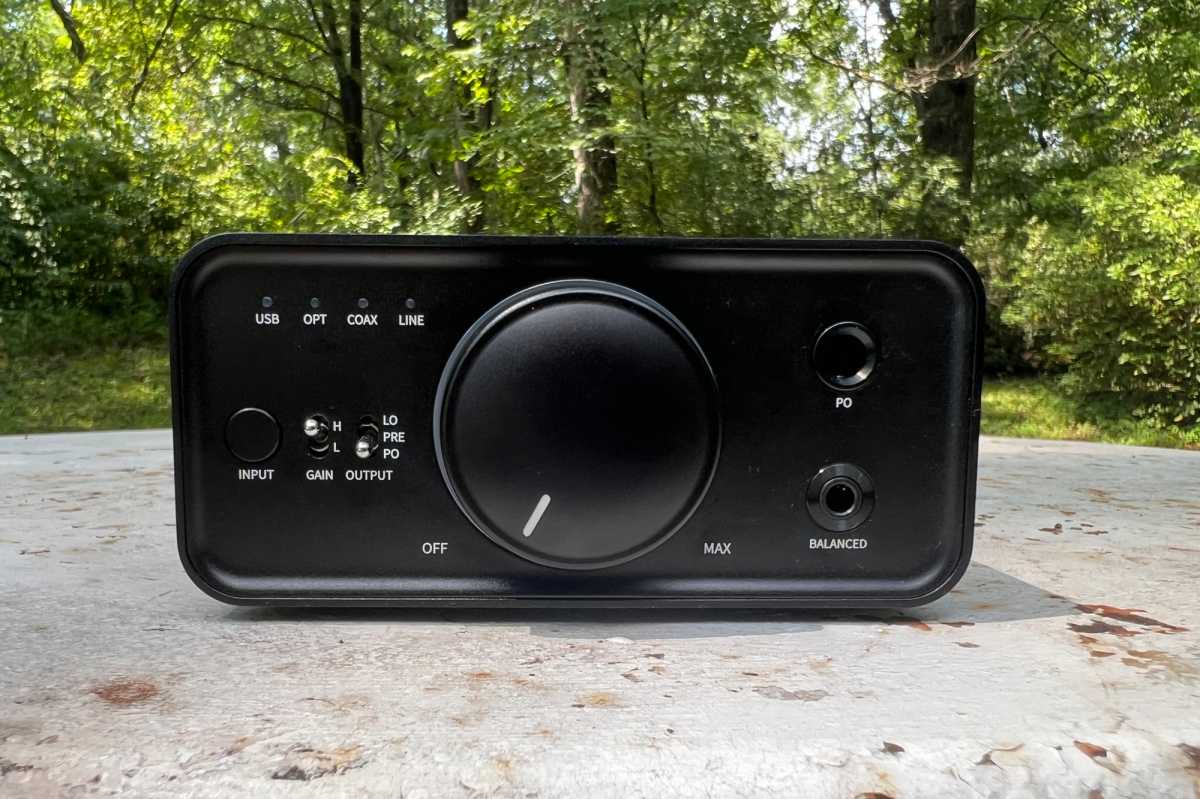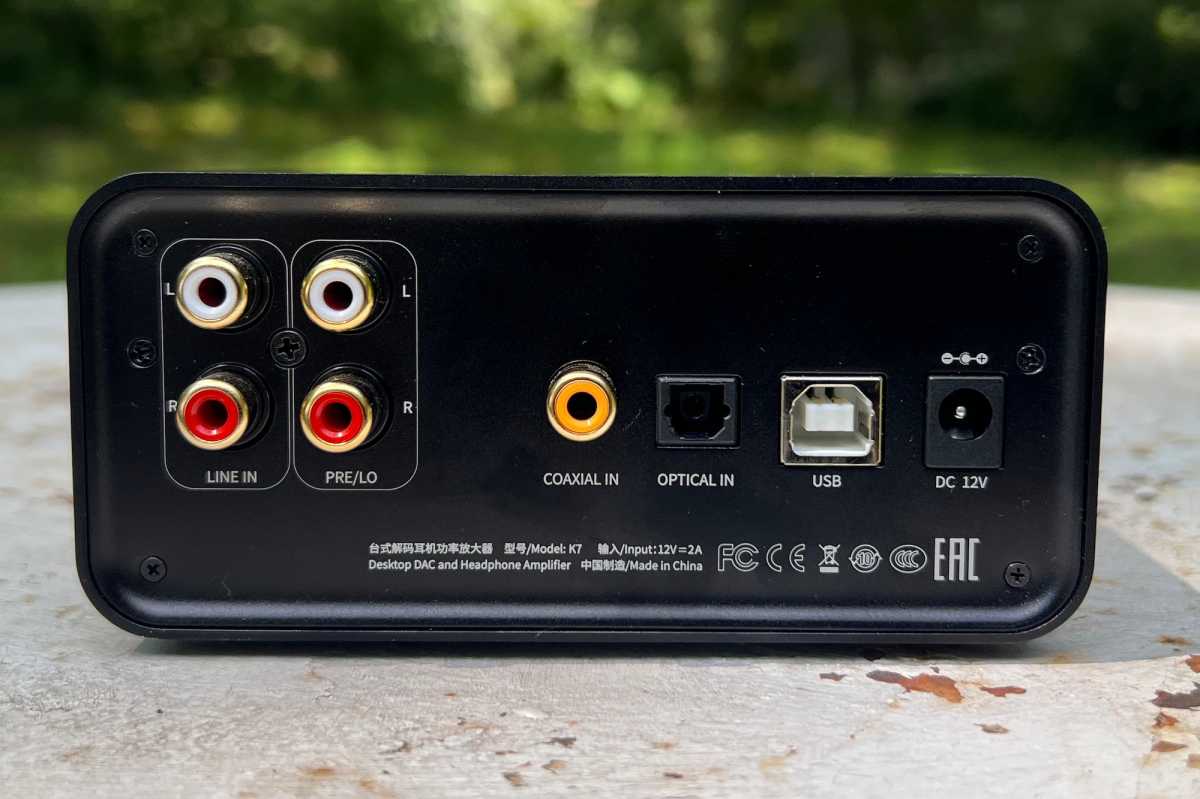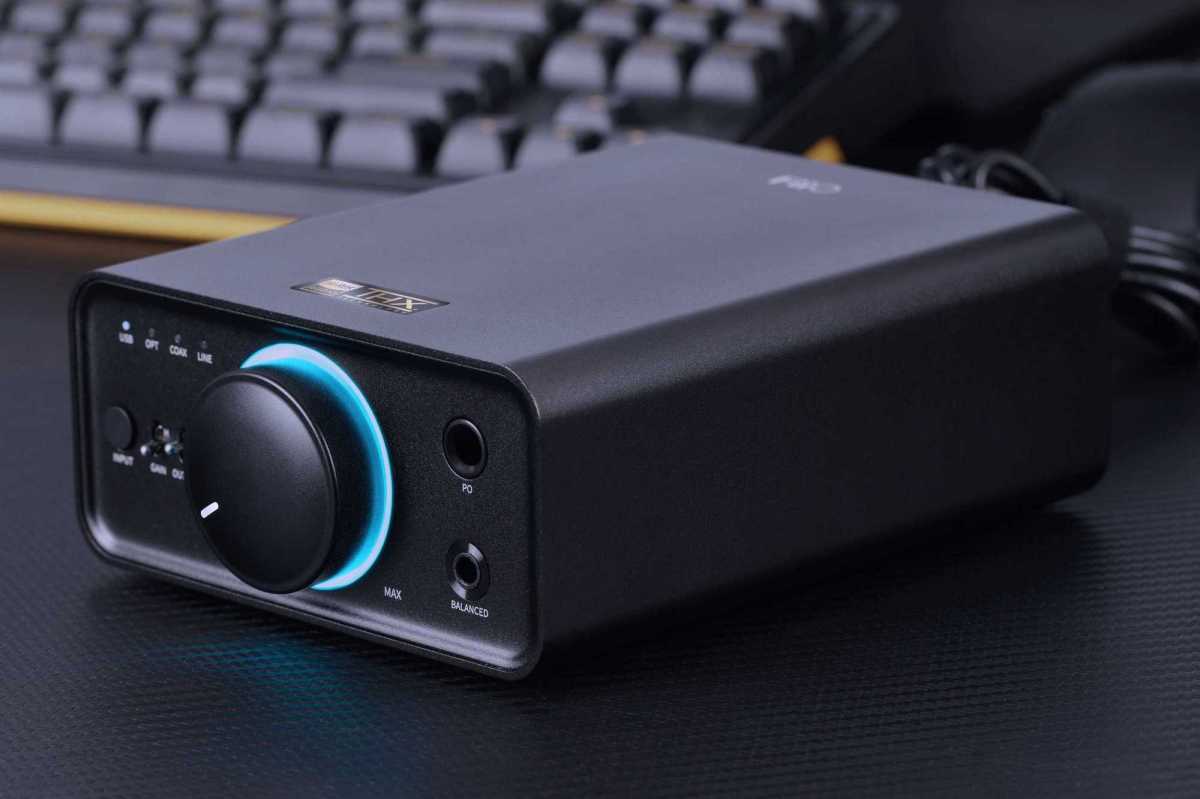At a glance
Expert’s Rating
Pros
- Solid build quality and a physical volume knob
- Outstanding audio detail
- 4.4mm balanced and ¼-inch (6.35mm) unbalanced headphone outputs
Cons
- No way to turn off LED light that circles its volume knob
- No MQA support
- Matte finish is a fingerprint magnet
Our Verdict
The Fiio K7 will dramatically improve the quality of your desktop listening. Skip your computer’s audio jack and plug the K7 into its USB port for a true revelation.
Price When Reviewed
$199.00
Best Prices Today: Fiio K7
$199.99
The Fiio K7 desktop DAC and headphone amplifier is a remarkable value for anyone looking to improve their computer’s audio output. It’s not portable, nor is it designed to amplify audio for anything besides wired headphones or in-ear monitors. You can also bypass its amp and send analog audio to powered speakers.
Audiophiles spend thousands of dollars on these units, but Fiio has delivered an entry-level model that compares favorably to DAC/amp combos that cost several times its $199 price. If you’ve acquired a good pair of wired headphones, the Fiio K7 will help you get the most out of your investment.
The Fiio K7 features dramatic stereo separation and an impressively wide soundstage. It’s a terrific DAC/headphone amp for the price.
Why would you want a desktop DAC/amp combo?
The digital-to-analog converter chip in your computer isn’t designed to get the best sound out of your music or movie files, and the electronically noisy space it operates in doesn’t help matters. Most users don’t use their computers as an entertainment hub anyway, so PC manufacturers stick to DACs that merely get the job done.
This review is part of TechHive’s in-depth coverage of the best wired headphones.
No matter whether you’re using a hi-res option like Qobuz, lossy Spotify, YouTube, or even a library of old 128Kbps MP3s you downloaded from Napster back in the day, a good external DAC will dramatically improve the quality of your listening experience. If you’re only using easy-to-drive earbuds, you might be happy with a USB DAC like the excellent DragonFly series from AudioQuest (here’s a link to my DragonFly Cobalt review).

The Fiio K7 has an external power brick to reduce the amount of electrical noise inside its enclosure.
James Barber/Foundry
If you’ve invested in wired over-ear headphones that present higher impedance (these are TechHive’s best picks in wired headphones), you’ll want to consider a DAC with a built-in amplifier to meet their more demanding power needs.
A desktop DAC can also bypass its headphone amplifier and send an analog signal to a pair of powered speakers. If you’re looking to use an old pair of passive mini speakers, you’ll need a separate amplifier. You could get a good (and small) one for less than $100 from manufacturers like Fosi or Aiyima, but your desk may start to get a bit crowded at that point.
Fiio K7 build quality
The Fiio K7 is housed in a black aluminum case and features a physical button for input selection and a switch for output options along with a rotary volume control knob. The unit feels incredibly solid, even if the matte finish on the case turns out to be somewhat of a fingerprint magnet.
The unit measures 2.2 x 4.7 W x 6.6 inches (HxWxD) and weighs just 1.3 lbs. The K7 uses an external power brick to reduce noise.
Fiio has included two AK4493SEQ DAC chips (one for each channel) and an XMOS XUF 208 microcontroller. For the headphone amp, they’ve included dual THX AAA 788+ modules that are usually found in far more expensive gear (here again, one for each channel). Fiio touts the presence of six different audio circuits designed to reduce crosstalk.

The controls on the front of the Fiio K7 are well-labeled and simple to use. The DAC/headphone amp supports both balanced and unbalanced headphones.
James Barber/Foundry
Digital audio inputs include USB, coax, and Toslink optical, and there are RCA inputs so you can add a turntable cassette player or other analog source to the mix. There are also RCA analog outputs for bypassing the internal amp and sending the decoded analog signal to powered speakers or an external preamp or amplifier.
The front of the unit features an input button that allows you to switch between USB, optical, coax, and RCA inputs. A three-way output switch cycles between the internal headphone amp, a flat line-out signal, or a line-out signal whose volume responds to the volume knob.
The volume knob turns on the power and is ringed by an RGB light that shows the resolution of the files as they’re decoded by the DAC. A blue light indicates a PCM signal below 48kHz, yellow means it’s 48kHz or higher, and the light turns green with for a DSD stream.
The K7 supports PCM audio up to 32-bit/384kHz and DSD256 via the USB port, PCM audio up to 24-bit/192kHz via the coaxial port, and PCM audio up to 24-bit/96 kHz via the optical port. Note that the Fiio K7 does not support the MQA standard, which seems to be less of an issue for most users now that Tidal is moving away from MQA and replacing it with FLAC audio files.
Fiio also offers a Bluetooth option
If you’re looking to stream music from a smartphone or tablet, Fiio also offers a Bluetooth model: the $249 K7 BT. That unit uses Qualcomm’s QCC5214 Bluetooth 5.1 chipset and supports Sony’s LDAC in addition to Qualcomm’s own aptX HD and aptX Adaptive codecs.
Why would you need Bluetooth in a desktop amplifier? It might seem like overkill for a unit designed to be tethered to both a computer and headphones, but anyone using the Fiio with powered speakers in a dorm room or studio apartment might appreciate the ability to stream music from across the room.
Listening to the Fiio K7

Digital audio inputs on the Fiio K7 consist of USB, coax and optical. The DAC/headphone amp is also outfitted with analog RCA inputs and outputs.
James Barber/Foundry
I used an Audeze MM-500 planar magnetic headphone and a Sony MDR-7506 studio headphone when testing the Fiio K7. The Audeze are pro-quality reference cans and the Sony remain my favorite entry-level wired headphones after more than two decades on the market. I chose Qobuz as the hi-res music source on my Mac Mini. The K7 was connected to the Mac via an AudioQuest Cinnamon USB cable.
I do have one complaint about the K7. The volume knob does not offer a smooth ramp up on the audio volume. There’s very little increase in loudness from 0 to 50 percent, and there’s a huge jump in volume at around 60 percent. It’s not difficult to eventually land on the right volume, but anyone who’s a fan of precision knob control will find themselves a bit frustrated.
Listening to a 24-bit/96kHz stream of Scott Walker’s 1967 debut solo LP Scott was a revelation. The heavily orchestrated arrangements on tracks like “Montague Terrace (In Blue)” and “My Death” feature dramatic stereo separation. There’s a lot of musical traffic in these mixes, but there was plenty of space between the individual instruments and the soundstage was impressive.

The light ring around the Fiio K7’s volume-control knob make it easy to find in a dark room; unfortunately, there’s no option to turn it off.
James Barber/Foundry
“Angel of Death,” from the 1986 Slayer LP Reign in Blood, was equally powerful in a 24-bit/96kHz Qobuz stream. The band and producer Rick Rubin decided to skip the booming 1980s drums that dominated the era for a sound that emphasizes Tom Araya’s vocals and the guitar interplay of Kerry King and Jeff Hanneman. Reign in Blood was a record that seemed too loud to be contained on vinyl in its initial pressings. I’ve never heard it sound better than it does via the Fiio K7.
That includes how it sounded when I switched over to the $799 iFi Neo iDSD desktop DAC, amplifier, and Bluetooth receiver. I preferred my metal via the Fiio K7.
The iFi unit does feature more precise controls than the Fiiio K7, and there’s consistently finer detail when listening to jazz, classical or the Scott Walker album mentioned above. The gap between the K7 and the iFi that costs four times as much is not an enormous one, a fact that makes the Fiio an even better value.
Should you buy the Fiio K7?
Anyone who’s listening to music or watching videos while sitting at a desk will appreciate the improved audio delivered by the Fiio K7. While I’ve used the K7 as a standalone external DAC between a WiiM Pro streamer and a Fosi Audio TB10D amplifier in a home audio setup, you’ll want to look elsewhere if you just need a DAC unit and not the headphone amp. There are excellent DACs around $100 from manufacturers like Schiit and Topping.
The Fiio K7 is easy to use, offers remarkable audio detail for its price, and never introduced any ear fatigue during long playback sessions. If you’re looking to maximize your headphone listening experience while staying within a budget, the K7 will deliver.


